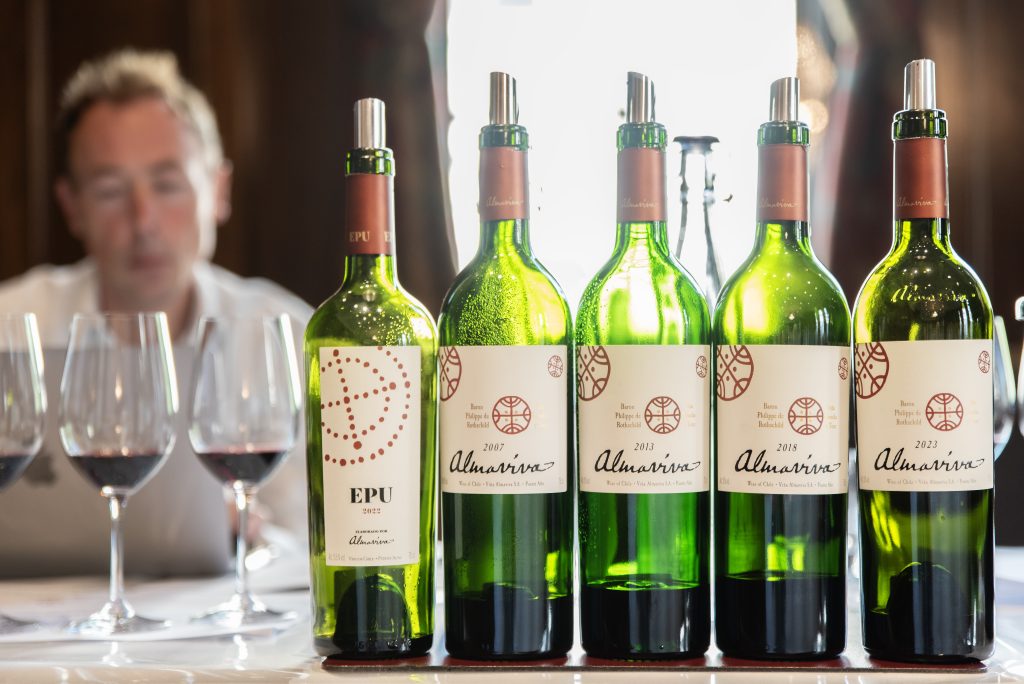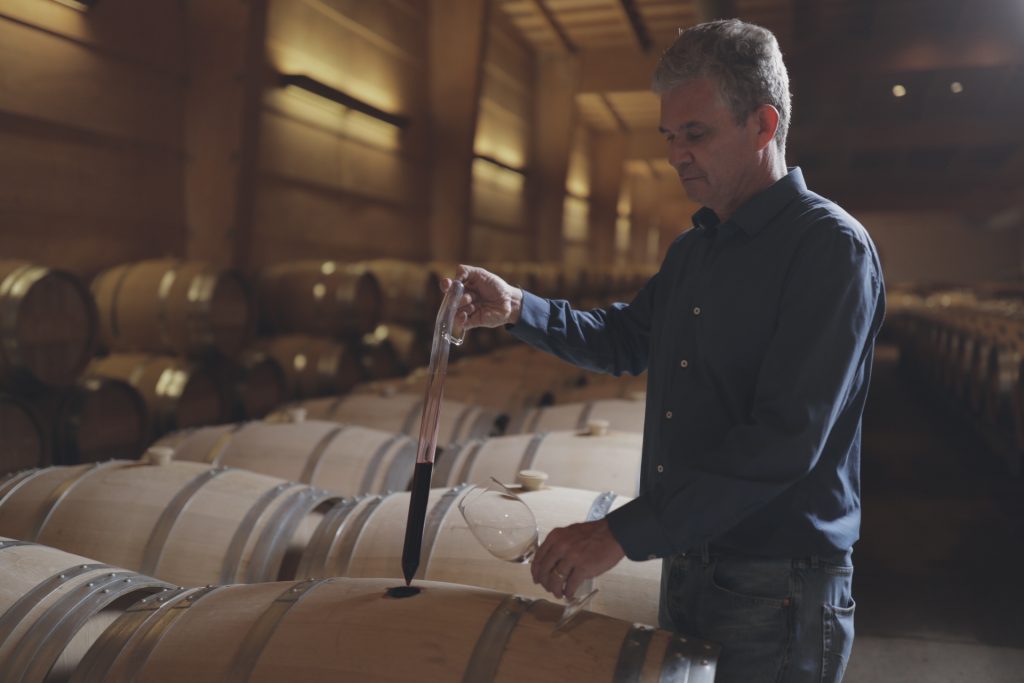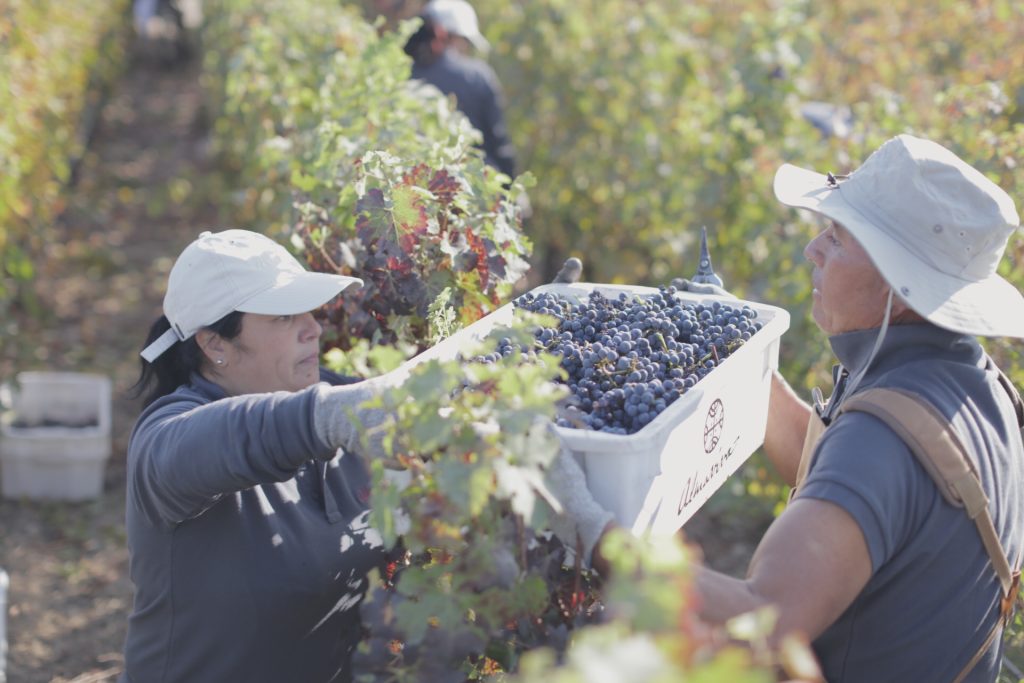Inspired by France but made in Chile, Almaviva unites Old and New Worlds in one label. At a recent London masterclass, db discovered how it balances those influences and what to expect from its latest, notably hot, vintage: Almaviva 2023.

The story of fine wine – thank goodness – is no longer the story of just a handful of regions. The likes of Bordeaux and Burgundy certainly have the benefits of longstanding reputation. However, relatively emergent regions and younger wineries are proving that the journey need not take centuries. There is a global wealth of fine winemakers: one need only look at La Place de Bordeaux’s hors Bordeaux campaigns to see an industry with a worldwide span.
In this relatively recent landscape of international fine wine, Chile has a fascinating position. If you consider Bordeaux the epicentre of the fine wine trade, and its wines thus fine wine archetypes, then Chile could easily pass as its transatlantic cousin. Both are best known for their red wines. Both have made a star of Cabernet Sauvignon (and after all, Chile’s most distinct speciality, Carmenere, is a forgotten Bordeaux variety). Both have also proved themselves adept at balancing intensity against freshness, and fruit against oak.
Arriving in London for a tasting of Chilean icon wine Almaviva, therefore, you felt on solid ground. Introduced by Patrick Schmitt MW and led by Michel Friou, technical director at Almaviva, the tasting guided attendees through vintages dating back to 2007 and premiered the 2023 release. From the grand setting to the minutiae of vintage patterns, the event fit the mould for a fine wine experience.
In fact, Almaviva stands out for its bridging of fine wine worlds. The winery is both steeped in tradition and a highly modern project. Conceived as a French and Chilean collaboration – the joining of Baron Philippe de Rothschild and Viña Concho y Toro – it is a complex meeting of worlds. The result, however, is clear: a fine wine with a global profile.
 Patrick Schmitt MW introduced the masterclass.
Patrick Schmitt MW introduced the masterclass.
Crossing oceans
Even glancing at the bottle, you will see the two companies’ influences, even if you do not realise it. From the beginning, collaboration has been at the centre of the branding.
“It was important for the two companies to have the two cultures presented on the label,” explained Friou. The graphics show traditional Chilean representations of the Earth, the cosmos and the seasons – forces which dictate the production of wine, regardless of style or origin.
The name, meanwhile, derives from Count Almaviva, a character in the classic French play The Marriage of Figaro by Beaumarchais. It is not just a matter of national pride, but also family history: Baroness Philippine de Rothschild married one of Beaumarchais’ descendants.
Yet the connection is not just a gesture. In the collaborative endeavour, plenty of practices and inspirations made the journey from France to Chile.
You find it in the blend. Many great red wines around the world are led by Cabernet Sauvignon, but at Almaviva, the assemblage is unequivocally a Bordeaux blend. Cabernet Sauvignon, usually somewhere around 70% of the blend (and 73% in Almaviva 2023), is balanced by Cabernet Franc, Petit Verdot and, of course, Carmenere. The subtle calibration of a blend, a practice honed over centuries in Bordeaux, has been imported.
There are, of course, adaptations to Almaviva’s Chilean landscape. Although a Bordeaux variety, Carmenere is barely seen in its homeland. Yet at Almaviva, it averages around 20% of the blend. Its role is similar to that of Merlot on Bordeaux’s left bank, softening the structured, intense Cabernet Sauvignon. Indeed, though Merlot was introduced to the blend in 2006, its use in Almaviva was phased out by 2019; Carmenere simply does the job better.
 The ageing regimen is one of many French influences.
The ageing regimen is one of many French influences.
In winemaking too, the influence of Bordeaux is clear. Almaviva employs a ‘château concept’, with terroir, bodega and technical team united under a single banner. In a country with ample land for winemaking, it is notable for its precision.
The French approach thus extends to Almaviva’s winemaking: Friou described it as a “quite traditional” regime. The fermentation takes place in stainless steel, followed by two to three weeks of maceration at around 25°C. Over the years, the length and temperature of that maceration have both been reduced, a careful move to prevent over-extraction. The wines then mature in French oak – around 75% of it new – for 18 to 20 months.
Schmitt commented on the creaminess and generosity of the wines on show, a contrast to some Chilean examples that can prove to be taut and linear. Indeed, he speculated whether this was the Rothschild influence shining through – evidence in the glass of the transatlantic influence.
Rooted in Chile
Almaviva is, however, undeniably a product of Chilean terroir. Its Cabernet Sauvignon, the backbone of the blend, grows in Puente Alto. Despite being within the metropolitan area of Santiago, it is unmistakably born of the Chilean landscape, with the Andes and the Maipo river as key influences.
The winery building’s undulating roof is a nod to the nearby mountains. Though Puente Alto sits on broadly flat ground, within just a few kilometres the terrain is truly mountainous. Cool air descends the slopes, though it is worth noting that altitude cools even the flats; the vineyards sit at 620 metres in elevation.
Such cooling factors are essential. Puente Alto is about as close to the Equator as Los Angeles, meaning intense sunlight to ripen the fruit. Yet the wine does not become overripe: cooler temperatures, especially at night, preserve the grapes’ acidity. Almaviva thus shows a compelling combination of intensity and freshness.
Friou admits that, thanks to the abundant sunlight, the alcohol on the wines is at the higher end of the spectrum, but he does not believe that diminishes the quality. “We naturally have this balance between freshness and ripeness,” he commented. Indeed, the well-integrated alcohol became a talking-point at the session, with the wines on display wearing 15% ABV lightly.
 Careful picking secures the grapes at optimal ripeness.
Careful picking secures the grapes at optimal ripeness.
The Maipo river also has a notable effect. It moderates hotter temperatures – helpful for making Almaviva 2023 – provides a very necessary source of irrigation and has, over millennia, transported rocks from the Andes to create geologically complex soils.
Of course, as climate change impacts all winegrowing regions, adaptations are necessary. Irrigation has long been a necessity – “not an option, but clearly an obligation”, in Friou’s words – but now other choices come into play.
Friou explained that vintage variation in the areas amounts to two core considerations: the amount of rainfall in the winter months and the season’s overall temperature. Though the first consideration is largely addressed by irrigation, hotter years now require changes in the vineyard. Often that means prioritising freshness at harvest: “We have seen, over the last 10 years, a big difference in picking times,” explained Friou.
Still, the area is resilient. Even in the warmest of years, Friou and his team are not facing heatwaves that would fundamentally change the character of the wine. “Even in the warmest vintage, we have a maximum of 37ºC or 38ºC one day at 5pm,” he said. “We never see the temperatures up to 45ºC that have happened in California, or Spain or Portugal. This is the positive aspect of the place, so close to the mountains.”
The latest release
The session offered a chance to hear from an expert winemaker, as well as a rare opportunity to conduct a vertical tasting of fine wines. However, it also had the notable appeal of showcasing the newly released Almaviva 2023 release.
 Friou led attendees through a vertical tasting.
Friou led attendees through a vertical tasting.
Available on La Place de Bordeaux since September, Almaviva 2023 is no radical departure from the winery’s distinctive style. Cabernet Sauvignon makes up the bulk of the blend (74%), with Carmenere in a supporting role (19%). Bordeaux varieties Cabernet Franc and Petit Verdot complete the assemblage. The ageing also matches the broad pattern: 20 months in French oak, 73% of which is new.
The wine does, however, offer a taste of a strong, if at points challenging, season. An unusually dry winter and spring caused early pressure, even if they were a welcome improvement on exceptionally dry conditions the year before. The early conditions for the vintage were uneven, with a late budbreak and some coulure.
The key challenge came with summer and its heat. March was the hottest yet recorded in Chile, while April and May were 1.4ºC and 1ºC above the average respectively. Although, as Friou established, Puente Alto does not suffer as extreme heat as other regions, such heat could nonetheless impact the wine. The challenge was to preserve acidity, leading to earlier picking, beginning on 13 March.
The vintage bears the hallmarks of a warmer year, but the early picking succeeded. Indeed, Friou’s summary of the wine indicates that a hot, dry vintage is no impediment to the winery’s work.
“We could have expected a much more concentrated, full-bodied year, but we think it is a wine with lots of fruit expression, juiciness and roundness, still with all the structure. It is a quite accessible year,” he said.
Certainly the wine held up to that description. Even in such youth, it balanced complexity against an approachable profile. Though designed for ageing – Friou likes to drink his after 15 to 18 years in the cellar – the appeal was immediate. Perhaps that is another way Chile is subtly rewriting fine wine rules; for some at the tasting, it may well prove too delicious to wait.
Related news
ASC Fine Wines partners with Waigaoqiao ITOC
Sotheby’s auctions Lafite private and ex-château cellar wines
Three sommeliers pick their wickedly good Halloween wine pairings


Dining and Cooking